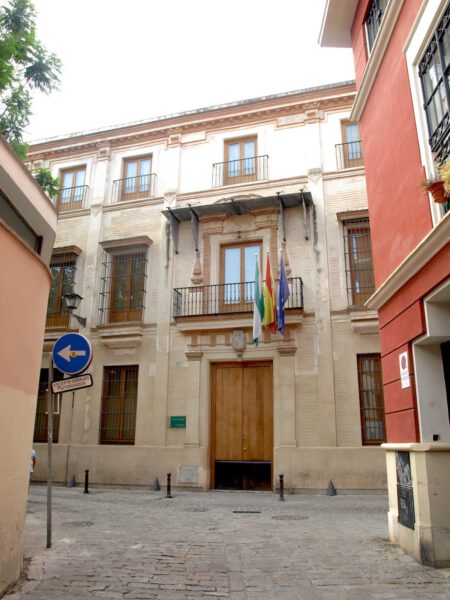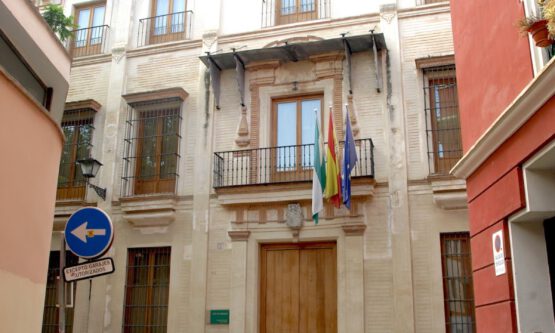PALACIO DE MARCHENILA
Located in the neighborhood of San Bartolomé, the
house that occupies number 18 of
the Conde de Ibarra street in Seville, is a clear example of Sevillian noble
architecture, which evolved from the late medieval to the baroque, from
nineteenth-century tastes to adaptation for administrative use with current
criteria. The street where the house is located, today Conde de Ibarra, was
named in the XV century of Toqueros, because it was installed in it by textile
craftsmen who made toques.
Located in the neighborhood of San Bartolomé, the
house that occupies number 18 of
the Conde de Ibarra street in Seville, is a clear example of Sevillian noble
architecture, which evolved from the late medieval to the baroque, from
nineteenth-century tastes to adaptation for administrative use with current
criteria. The street where the house is located, today Conde de Ibarra, was
named in the XV century of Toqueros, because it was installed in it by textile
craftsmen who made toques.
Supported its facade on the old Jewish wall, the
structure of the house recalls the typical Roman and Muslim houses, where the
courtyards and gardens take center stage and symbolically lead us to Roman
Olympus, Christian Eden and Muslim paradise. These open spaces have lasted over
time adapting to new needs. The first documented references to his occupation
lead us to the seizure of the assets of the Jewish religious minority expelled
from the neighborhood of San Bartolomé and of his donation, by Enrique III, to
the justice of the land Diego López de Zúñiga, who was also the owner of the
neighbor Palace of Altamira.
structure of the house recalls the typical Roman and Muslim houses, where the
courtyards and gardens take center stage and symbolically lead us to Roman
Olympus, Christian Eden and Muslim paradise. These open spaces have lasted over
time adapting to new needs. The first documented references to his occupation
lead us to the seizure of the assets of the Jewish religious minority expelled
from the neighborhood of San Bartolomé and of his donation, by Enrique III, to
the justice of the land Diego López de Zúñiga, who was also the owner of the
neighbor Palace of Altamira.
In the second half of the 15th century it was again donated to the bachelor
Fernando Díaz de Córdova, whose children would sell it in 1483 to Pedro Manuel
de Lando, illegitimate son of a Sevillian family of nobility, councilor of the
town council since 1474, who was benefited by the Catholic Kings for their
frequent and loyal support for the crown. In 1502 it passed into the hands of
the Alcocer family, contractors transporting goods and slaves to the Indies.
Descendants of the latter occupied the house during the sixteenth and seventh
centuries and will be in the last decades of the eighteenth century when it
falls on the family of hidalgos of Santa Marina.
Fernando Díaz de Córdova, whose children would sell it in 1483 to Pedro Manuel
de Lando, illegitimate son of a Sevillian family of nobility, councilor of the
town council since 1474, who was benefited by the Catholic Kings for their
frequent and loyal support for the crown. In 1502 it passed into the hands of
the Alcocer family, contractors transporting goods and slaves to the Indies.
Descendants of the latter occupied the house during the sixteenth and seventh
centuries and will be in the last decades of the eighteenth century when it
falls on the family of hidalgos of Santa Marina.
In the last third of the eighteenth century we saw the
semi-ruinous state in which the house was located, so the municipal council
urges its rehabilitation or forced sale to anyone who can carry out its
reconstruction. The situation causes its sale by auction, being acquired by Don
Francisco Keyser, a Ghent flamenco merchant based in Seville.
semi-ruinous state in which the house was located, so the municipal council
urges its rehabilitation or forced sale to anyone who can carry out its
reconstruction. The situation causes its sale by auction, being acquired by Don
Francisco Keyser, a Ghent flamenco merchant based in Seville.
From this moment, the house takes on special splendor, endowing itself with
the physiognomy that we recognize today, even modifying part of its exterior by
settling one of its façade angles to remedy its narrowness, facilitating the
passage of carriages. Likewise, the Flemish merchant tried to make his back –
with access to the street that is still called Levíes and in which there was an
alley that was always cause for complaint to favor the shelter of homeless and
thugs – was part of the housing, at the same time that it allowed the private
access of carriages, for which it urged in several occasions to the Cabildo in
order to propose the new use always receiving the refusal of this one. This
period of modifications ends with the century when the Keyser family lost the
property due to a judicial embargo attributed to the efforts made by a partner
of the merchant with whom he had contracted a large debt.
the physiognomy that we recognize today, even modifying part of its exterior by
settling one of its façade angles to remedy its narrowness, facilitating the
passage of carriages. Likewise, the Flemish merchant tried to make his back –
with access to the street that is still called Levíes and in which there was an
alley that was always cause for complaint to favor the shelter of homeless and
thugs – was part of the housing, at the same time that it allowed the private
access of carriages, for which it urged in several occasions to the Cabildo in
order to propose the new use always receiving the refusal of this one. This
period of modifications ends with the century when the Keyser family lost the
property due to a judicial embargo attributed to the efforts made by a partner
of the merchant with whom he had contracted a large debt.
Throughout the nineteenth century sales and temporary
transfers with their consequent changes of residents, until in 1854 the house
is purchased by the Romero family, military high-ranking participants in the
wars of independence and emancipation of the Spanish colonies .
transfers with their consequent changes of residents, until in 1854 the house
is purchased by the Romero family, military high-ranking participants in the
wars of independence and emancipation of the Spanish colonies .
The widow of the distinguished military man will
bequeath to his grandchildren, being, among them, Cecilia who would maintain
the property until the beginning of the 20th century, transferring it to her
children, who will live there until 1934.
bequeath to his grandchildren, being, among them, Cecilia who would maintain
the property until the beginning of the 20th century, transferring it to her
children, who will live there until 1934.
From 1937 the house was used as a free Catholic
school, a residence for noble families and, from 1940 onwards, a printing
workshop for a businessman from A Coruña. Subsequently it would be the property
and commercial headquarters of Miguel Ybarra Pharmaceutical Industries, who was
mayor of the city between 1940 and 1943. Small bourgeois representative of an
emerging self-sufficient industry that would install in the house its
laboratory and warehouse until, at the end of the years Sixty, the company will
disappear.
school, a residence for noble families and, from 1940 onwards, a printing
workshop for a businessman from A Coruña. Subsequently it would be the property
and commercial headquarters of Miguel Ybarra Pharmaceutical Industries, who was
mayor of the city between 1940 and 1943. Small bourgeois representative of an
emerging self-sufficient industry that would install in the house its
laboratory and warehouse until, at the end of the years Sixty, the company will
disappear.
Once again, the inheritance and the distribution led
this farm to change owners, remaining in 1969 in the hands of the Discalced
Carmelites of San José de Dos Hermanas, being mortgaged by them as an economic
resource in 1977.
this farm to change owners, remaining in 1969 in the hands of the Discalced
Carmelites of San José de Dos Hermanas, being mortgaged by them as an economic
resource in 1977.
The farm, as it will happen in many of the surrounding
manor houses, suffers from that moment the consequences of abandonment and
degradation, being practically in a ruinous state. During this period is
acquired by a real estate group that aims to unify several properties to
convert them into garages and homes -in which we are concerned was built part
of a basement in the rear area- without the management came to occur. P.G.O.U.
of Seville in 1985 declared it as a palace, suggesting expropriation to avoid deterioration.
manor houses, suffers from that moment the consequences of abandonment and
degradation, being practically in a ruinous state. During this period is
acquired by a real estate group that aims to unify several properties to
convert them into garages and homes -in which we are concerned was built part
of a basement in the rear area- without the management came to occur. P.G.O.U.
of Seville in 1985 declared it as a palace, suggesting expropriation to avoid deterioration.
Of the building we can emphasize in the first place
its facade, divided in three bodies and where the restoration has been more
intense integrating the remains found, of classic drawings and avitoladas
lines. The apilastrado of the same and part of his rejería shows us its richest
aspect. The ground floor, the main door, centered, of great size crowned with
blazon, that gives access to the vestibule. The second body is structured with
large windows and balcony with tejaroz. The last floor has a series of windows
with a gable roof, possibly destined for storage.
its facade, divided in three bodies and where the restoration has been more
intense integrating the remains found, of classic drawings and avitoladas
lines. The apilastrado of the same and part of his rejería shows us its richest
aspect. The ground floor, the main door, centered, of great size crowned with
blazon, that gives access to the vestibule. The second body is structured with
large windows and balcony with tejaroz. The last floor has a series of windows
with a gable roof, possibly destined for storage.


An intriguing discussion is worth comment. I do think that you should write more on this topic, it might not be a taboo subject but typically folks dont discuss these issues. To the next! All the best!!
I was very happy to find this great site. I want to to thank you for your time due to this fantastic read!! I definitely savored every little bit of it and I have you saved to fav to see new stuff in your web site.
Good post. I learn something new and challenging on websites I stumbleupon on a daily basis. Its always interesting to read articles from other writers and practice something from other sites.